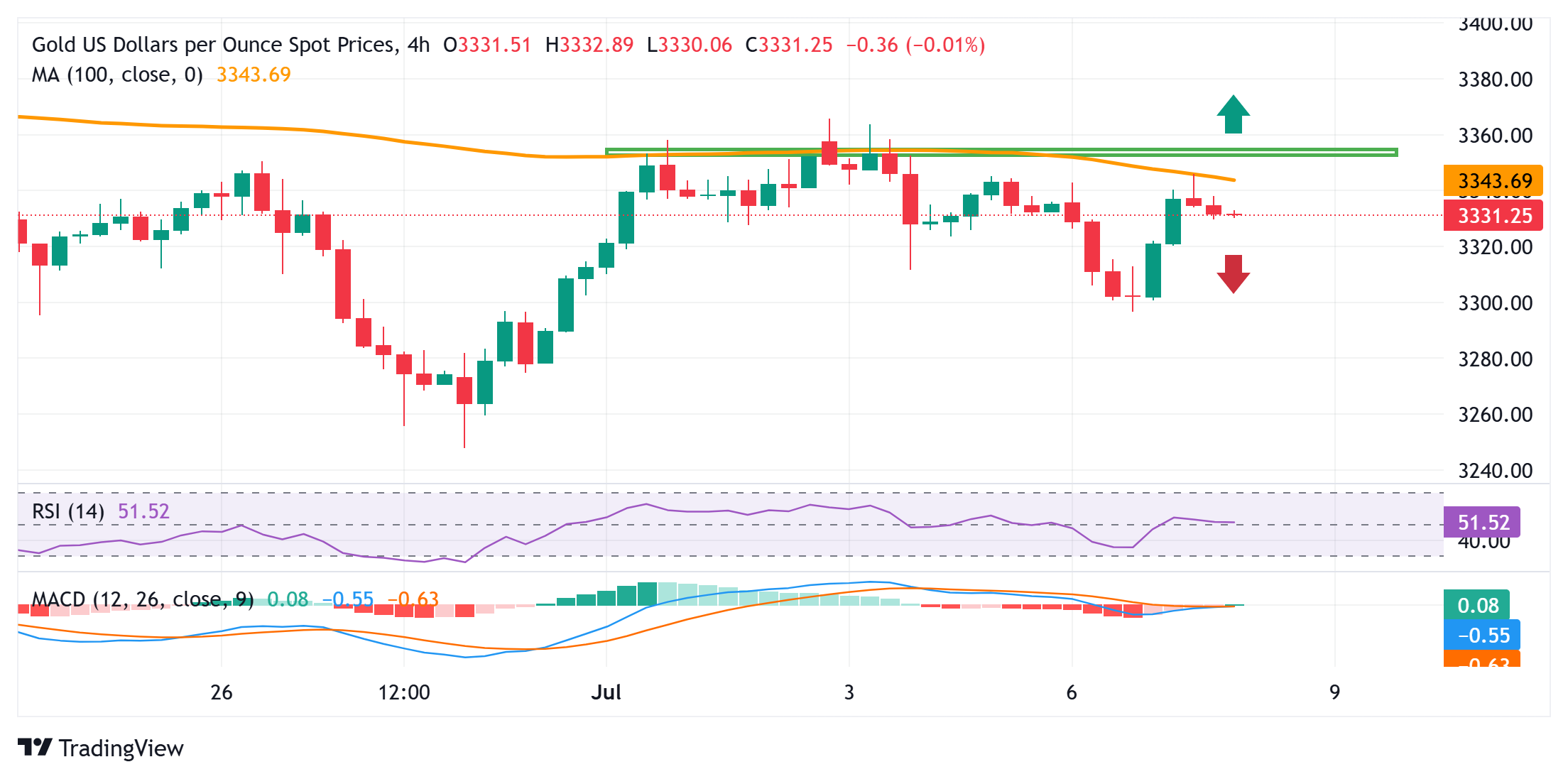Gold price drifts lower as reduced Fed rate cut bets offset trade jitters
- Gold price attracts fresh sellers amid diminishing odds for a rate cut by the Fed in July.
- Concerns about the economic fallout from Trump’s tariffs weigh on investors’ sentiment.
- The emergence of some USD weakness might contribute to limiting losses for the XAU/USD pair.
Gold price (XAU/USD) struggles to capitalize on the previous day's goodish rebound from a one-week low – levels just below the $3,300 mark – and trades with a mild negative bias during the Asian session on Tuesday. Expectations that US President Donald Trump's tariffs would underpin US inflation in the coming months and force the Federal Reserve (Fed) to keep interest rates steady act as a headwind for the non-yielding yellow metal. However, a combination of factors might hold back traders from placing aggressive bearish bets and help limit the downside for the commodity.
Investors remain on edge amid worries about the potential economic fallout from Trump's so-called reciprocal tariffs. This, along with persistent geopolitical risks, takes its toll on the global risk sentiment and should benefit the safe-haven Gold price. Apart from this, the emergence of some US Dollar (USD) selling could offer some support to the precious metal. Traders might also opt to wait for more cues about the Fed's rate-cut path before positioning for the next leg of a directional move. Hence, the market focus will remain glued to the release of the FOMC meeting minutes on Wednesday.
Daily Digest Market Movers: Gold price is pressured by expectations that the Fed will keep rates elevated
- US President Donald Trump extended the deadline for the imposition of reciprocal tariffs to August 1 and also released letters outlining higher trade tariffs against a slew of Asian and African countries. Trump also threatened that any Country aligning with the anti-American policies of BRICS will be charged an additional 10% tariff and there will be no exceptions to this policy.
- The Federal Reserve is now expected to keep interest rates elevated in anticipation of worsening inflation as a result of higher import taxes and a still resilient US labor market. This, in turn, lifted the US Dollar to a nearly two-week high on Monday and turned out to be a key factor that undermines demand for the non-yielding Gold price during the Asian session on Tuesday.
- The USD bulls, however, seem reluctant amid the uncertainty over the potential economic impact of Trump's tariffs and US fiscal concerns. Adding to this, a fresh wave of the global risk-aversion trade – as depicted by a sea of red across the global equity markets – could lend support to the safe-haven precious metal and warrants caution for aggressive bearish traders.
- In the absence of any relevant market-moving economic data from the US on Tuesday, the market focus will remain glued to the release of FOMC meeting minutes on Wednesday. Investors will look for more cues about the Fed's rate-cut path, which, in turn, will drive the USD demand in the near term and provide a fresh directional impetus to the non-yielding yellow metal.
Gold price seems vulnerable while below the 100-SMA on H4; bears need to wait for acceptance below $3,300

The overnight goodish rebound faced rejection near the 100-period Simple Moving Average (SMA) on the 4-hour chart. The said barrier is currently pegged near the $3,347-3,348 region and is followed by $3,358-3,360 supply zone. A sustained strength beyond the latter could trigger a short-covering move and allow the Gold price to reclaim the $3,400 round figure.
On the flip side, the $3,300-3,295 area might continue to protect the immediate downside, below which the XAU/USD pair could accelerate the fall towards the next relevant support near the $3,270 horizontal zone. The downward trajectory could get extended and eventually drag the Gold price to the $3,248-3,247 region, or the June monthly swing low.
Fed FAQs
Monetary policy in the US is shaped by the Federal Reserve (Fed). The Fed has two mandates: to achieve price stability and foster full employment. Its primary tool to achieve these goals is by adjusting interest rates. When prices are rising too quickly and inflation is above the Fed’s 2% target, it raises interest rates, increasing borrowing costs throughout the economy. This results in a stronger US Dollar (USD) as it makes the US a more attractive place for international investors to park their money. When inflation falls below 2% or the Unemployment Rate is too high, the Fed may lower interest rates to encourage borrowing, which weighs on the Greenback.
The Federal Reserve (Fed) holds eight policy meetings a year, where the Federal Open Market Committee (FOMC) assesses economic conditions and makes monetary policy decisions. The FOMC is attended by twelve Fed officials – the seven members of the Board of Governors, the president of the Federal Reserve Bank of New York, and four of the remaining eleven regional Reserve Bank presidents, who serve one-year terms on a rotating basis.
In extreme situations, the Federal Reserve may resort to a policy named Quantitative Easing (QE). QE is the process by which the Fed substantially increases the flow of credit in a stuck financial system. It is a non-standard policy measure used during crises or when inflation is extremely low. It was the Fed’s weapon of choice during the Great Financial Crisis in 2008. It involves the Fed printing more Dollars and using them to buy high grade bonds from financial institutions. QE usually weakens the US Dollar.
Quantitative tightening (QT) is the reverse process of QE, whereby the Federal Reserve stops buying bonds from financial institutions and does not reinvest the principal from the bonds it holds maturing, to purchase new bonds. It is usually positive for the value of the US Dollar.
